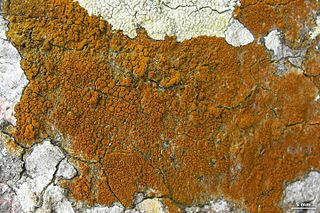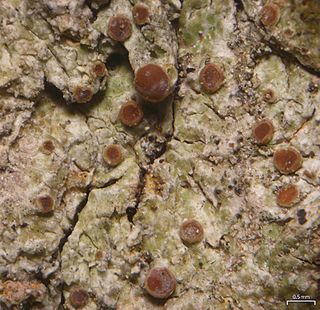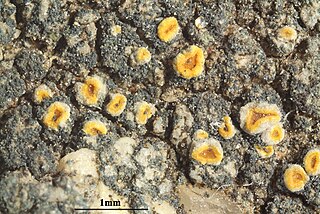
Athallia is a genus of lichen-forming fungi in the family Teloschistaceae. It was circumscribed in 2013 by Ulf Arup, Patrik Frödén, and Ulrik Søchting, and the type species is Athallia holocarpa. The genus name means "without a thallus".
Sirenophila is a genus of crustose lichens in the subfamily Teloschistoideae of the family Teloschistaceae. It has four species with an Australasian distribution.
Amundsenia austrocontinentalis is a species of saxicolous (rock-dwelling), crustose lichen in the family Teloschistaceae, and the type species of genus Amundsenia. Found in Antarctica, it was formally described as a new species in 2014 by Isaac Garrido-Benavent, Ulrik Søchting, Sergio Pérez-Ortega, and Rod Seppelt. The type specimen was collected by the last author from Mule Peninsula, where it was found growing on small stones in glacial till. The species epithet austrocontinentalis refers to its distribution in continental Antarctica.

Wetmoreana is a genus of lichen-forming fungi in the family Teloschistaceae. It comprises 15 formally described species, one subspecies, and three undescribed species of crustose or squamulose that are predominantly saxicolous (rock-dwelling). The genus is characterized by its distinct lobes, orange zeorine apothecia when present, and the frequent occurrence of asexual propagules such as schizidia, isidia, or soredia. A key diagnostic feature is the presence of calcium oxalate crystals in the thallus medulla of many species.

Lacrima is a genus of lichen-forming fungi in the family Teloschistaceae. It has four saxicolous (rock-dwelling), crustose species.
Elixjohnia is a genus of lichen-forming fungi in the family Teloschistaceae. It has four species of saxicolous (rock-dwelling), crustose lichens that occur in Australasia.

Obscuroplaca is a genus of lichen-forming fungi in the family Teloschistaceae. It contains three species of corticolous (bark-dwelling), crustose lichens.

Gondwania is a genus of lichen-forming fungi in the subfamily Xanthorioideae of the family Teloschistaceae. It comprises five species of crustose lichens.
Solitaria is a fungal genus in the family Teloschistaceae. It contains a single species, the corticolous (bark-dwelling), crustose lichen Solitaria chrysophthalma.
Usnochroma is a genus of lichen-forming fungi in the family Teloschistaceae. It has two species of crustose lichens. The genus was circumscribed in 2013 by lichenologists Ulrik Søchting, Ulf Arup, and Patrik Frödén, with Usnochroma carphineum assigned as the type species. The genus name refers to the yellowish-green colour of the thallus, which is caused by the substance usnic acid. Usnochroma species occur in Macaronesia, South Africa, the Mediterranean Basin, and Algeria.
Charcotiana is a single-species genus in the family Teloschistaceae. It contains the species Charcotiana antarctica, a crustose lichen found in Antarctica.
Sirenophila maccarthyi is a species of corticolous/lignicolous, crustose lichen in the family Teloschistaceae. It has a thallus that is whitish or greyish, often inconspicuous and not always continuous, which can appear darker or dirty grey near its numerous, clustered apothecia. Sirenophila maccarthyi is distributed across regions including Western Australia, New South Wales, Victoria, Tasmania, and New Zealand, in both coastal and inland habitats. It typically grows on the bark and dead wood of a wide range of trees and shrubs such as Acacia sophorae, Araucaria excelsa, and various Eucalyptus species.

Flavoplaca austrocitrina is a species of saxicolous (rock-dwelling), crustose lichen in the family Teloschistaceae. It is widely distributed in Europe, and has also been recorded in South America.

Flavoplaca maritima is a species of crustose lichen in the family Teloschistaceae. It is found in costal areas of Northern, Western, and Southern Europe. It mostly occurs on rocks, but has also been recorded growing on wood.

Flavoplaca oasis is a species of saxicolous (rock-dwelling), crustose lichen in the family Teloschistaceae. It is widely distributed across Europe, and has been reported in Western Asia, China, and North Africa.

Kuettlingeria soralifera is a saxicolous (rock-dwelling), crustose lichen species in the family Teloschistaceae, first described in 2006. It is similar to Kuettlingeria xerica but distinguished by the presence of soredia on its thallus.
Elixjohnia jackelixii is a species of saxicolous (rock-dwelling), crustose lichen in the family Teloschistaceae. It is found in Australia and New Zealand. The lichen is characterised by its unique multilayered appearance with outer sterile rings that are brownish or greenish-yellow and inner areoles that are whitish, yellowish, or greyish, often cracked to reveal the medulla underneath. Its fruiting bodies, or apothecia, are typically attached directly to the thallus and vary in colour and shape.
Scutaria is a single-species fungal genus in the family Teloschistaceae. It contains the species Scutaria andina, found in South America. The thallus of this lichen has a form that is intermediate between crustose and foliose.

Kuettlingeria neotaurica is a species of saxicolous (rock-dwelling), crustose lichen in the family Teloschistaceae.
Elenkiniana is a genus of lichen-forming fungi in the family Teloschistaceae. It has three species, all of which occur in Eurasia.










